Supporti
e Resistenze Support
and Resistance Think of security
prices as the result of a head-to-head battle between a bull (the buyer) and a
bear (the seller). The bulls push prices higher and the bears push prices lower.
The direction prices actually move reveals who is winning the battle. Using
this analogy, consider the price action of Phillip Morris in Figure 6. During
the period shown, note how each time prices fell to the $45.50 level, the bulls
(i.e., the buyers) took control and prevented prices from falling further. That
means that at the price of $45.50, buyers felt that investing in Phillip Morris
was worthwhile (and sellers were not willing to sell for less than $45.50). This
type of price action is referred to as support, because buyers are supporting
the price of $45.50. Figure 6
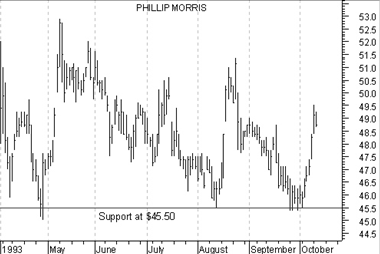 Similar
to support, a "resistance" level is the point at which sellers take control of
prices and prevent them from rising higher. Consider Figure 7. Note how each time
prices neared the level of $51.50, sellers outnumbered buyers and prevented the
price from rising. Figure 7
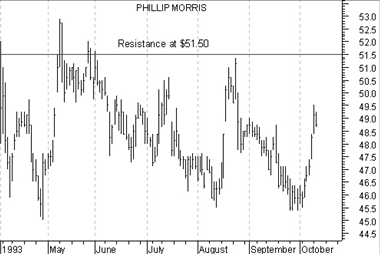 The
price at which a trade takes place is the price at which a bull and bear agree
to do business. It represents the consensus of their expectations. The bulls think
prices will move higher and the bears think prices will move lower. Support
levels indicate the price where the majority of investors believe that prices
will move higher, and resistance levels indicate the price at which a majority
of investors feel prices will move lower. But investor expectations change
with time! For a long time investors did not expect the Dow Industrials to rise
above 1,000 (as shown by the heavy resistance at 1,000 in Figure 8). Yet only
a few years later, investors were willing to trade with the Dow near 2,500. Figure
8
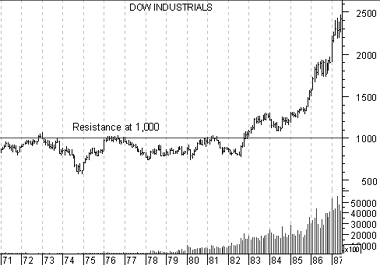 When
investor expectations change, they often do so abruptly. Note how when prices
rose above the resistance level of Hasbro Inc. in Figure 9, they did so decisively.
Note too, that the breakout above the resistance level was accompanied with a
significant increase in volume. Figure
9
 Once
investors accepted that Hasbro could trade above $20.00, more investors were willing
to buy it at higher levels (causing both prices and volume to increase). Similarly,
sellers who would previously have sold when prices approached $20.00 also began
to expect prices to move higher and were no longer willing to sell. The
development of support and resistance levels is probably the most noticeable and
reoccurring event on price charts. The penetration of support/resistance levels
can be triggered by fundamental changes that are above or below investor expectations
(e.g., changes in earnings, management, competition, etc) or by self-fulfilling
prophecy ( investors buy as they see prices rise). The cause is not as significant
as the effect--new expectations lead to new price levels. Figure 10 shows
a breakout caused by fundamental factors. The breakout occurred when Snapple released
a higher than expected earnings report. How do we know it was higher than expectations?
By the resulting change in prices following the report! Figure
10
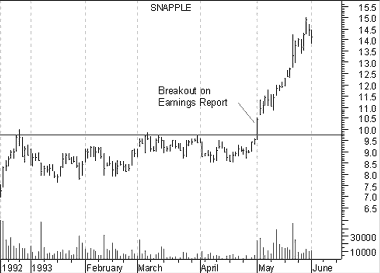 Other
support/resistance levels are more emotional. For example, the DJIA had a tough
time changing investor expectations when it neared 3,000 (see Figure 11). Figure
11
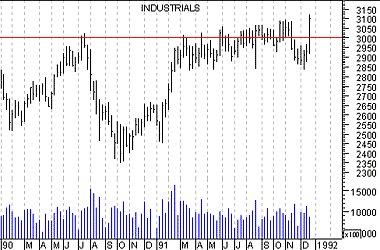
Supply and demand There is nothing mysterious
about support and resistance--it is classic supply and demand. Remembering "Econ
101" class, supply/demand lines show what the supply and demand will be at a given
price. The "supply" line shows the quantity (i.e., the number of shares)
that sellers are willing to supply at a given price. When prices increase, the
quantity of sellers also increases as more investors are willing to sell at these
higher prices. The "demand" line shows the number of shares that buyers
are willing to buy at a given price. When prices increase, the quantity of buyers
decreases as fewer investors are willing to buy at higher prices. At any
given price, a supply/demand chart (see Figure 12) shows how many buyers and sellers
there are. For example, the following chart shows that, at the price of 42-1/2,
there will be 10 buyers and 25 sellers. Figure
12
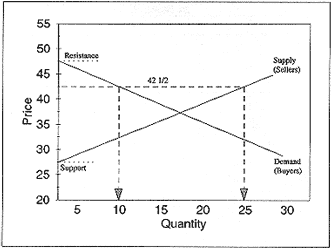 Support
occurs at the price where the supply line touches the left side of the chart (e.g.,
27-1/2 on the above chart). Prices can't fall below this amount, because no sellers
are willing to sell at these prices. Resistance occurs at the price where the
demand line touches the left side of the chart (e.g., 47-1/2). Prices can't rise
above this amount, because there are no buyers willing to buy at these prices. In
a free market these lines are continually changing. As investor expectations change,
so do the prices buyers and sellers feel are acceptable. A breakout above a resistance
level is evidence of an upward shift in the demand line as more buyers become
willing to buy at higher prices. Similarly, the failure of a support level shows
that the supply line has shifted downward. The foundation of most technical
analysis tools is rooted in the concept of supply and demand. Charts of security
prices give us a superb view of these forces in action. Traders' remorse
Following the penetration of a support/resistance level, it is
common for traders to question the new price levels. For example, after a breakout
above a resistance level, buyers and sellers may both question the validity of
the new price and may decide to sell. This creates a phenomena I refer to as "traders'
remorse" where prices return to a support/resistance level following a price breakout. Consider
the breakout of Phillip Morris in Figure 13. Note how the breakout was followed
by a correction in the price where prices returned to the resistance level. Figure
13
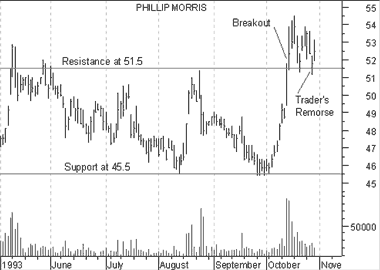 The
price action following this remorseful period is crucial. One of two things can
happen. Either the consensus of expectations will be that the new price is not
warranted, in which case prices will move back to their previous level; or investors
will accept the new price, in which case prices will continue to move in the direction
of the penetration. If, following traders' remorse, the consensus of expectations
is that a new higher price is not warranted, a classic "bull trap" (or "false
breakout") is created. As shown in the Figure 14, prices penetrated the resistance
level at $67.50 (luring in a herd of bulls who expected prices to move higher),
and then prices dropped back to below the resistance level leaving the bulls holding
overpriced stock. Figure 14
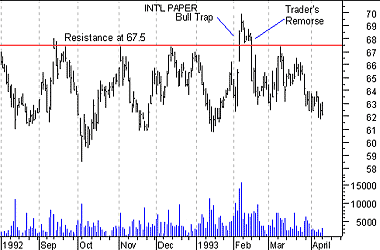 Similar
sentiment creates a bear trap. Prices drop below a support level long enough to
get the bears to sell (or sell short) and then bounce back above the support level
leaving the bears out of the market (see Figure 15). Figure
15
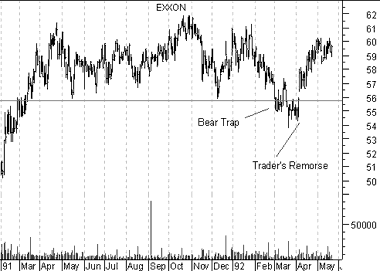 The
other thing that can happen following traders' remorse is that investors expectations
may change causing the new price to be accepted. In this case, prices will continue
to move in the direction of the penetration (i.e., up if a resistance level was
penetrated or down if a support level was penetrated). [See Figure 16.] Figure
16
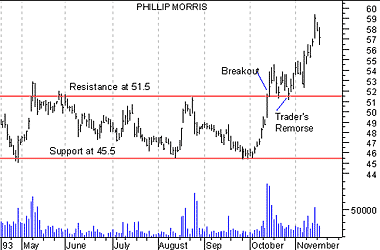 A
good way to quantify expectations following a breakout is with the volume associated
with the price breakout. If prices break through the support/resistance level
with a large increase in volume and the traders' remorse period is on relatively
low volume, it implies that the new expectations will rule (a minority of investors
are remorseful). Conversely, if the breakout is on moderate volume and the "remorseful"
period is on increased volume, it implies that very few investor expectations
have changed and a return to the original expectations (i.e., original prices)
is warranted. Resistance becomes support When
a resistance level is successfully penetrated, that level becomes a support level.
Similarly, when a support level is successfully penetrated, that level becomes
a resistance level. An example of resistance changing to support is shown
in Figure 17. When prices broke above the resistance level of $45.00, the level
of $45.00 became the new support level. This is because a new "generation"
of bulls who didn't buy when prices were less than $45 (they didn't have bullish
expectations then) are now anxious to buy anytime prices return near the $45 level. Figure
17
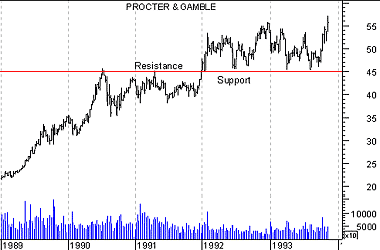 Similarly,
when prices drop below a support level, that level often becomes a resistance
level that prices have a difficult time penetrating. When prices approach the
previous support level, investors seek to limit their losses by selling (see Figure
18). Review I kept discussions of price
action, investor expectations, and support/ resistance as concise as possible.
However, from my experience working with investors, I am thoroughly convinced
that most investors could significantly improve their performance if they would
pay more attention to the underlying causes effecting security prices: investor
expectations and supply/demand. The following is a very brief review of
the support/resistance concepts discussed in this section. Figure
18
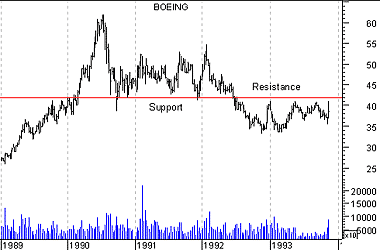
-
A security's price represents the fair market value as agreed between
buyers (bulls) and sellers (bears). -
Changes in price are the result
of changes in investor expectations of the security's future price. -
Support
levels occur when the consensus is that the price will not move lower. It is the
point where buyers outnumber sellers. -
Resistance levels occur when
the consensus is that the price will not move higher. It is the point where sellers
outnumber buyers. -
The penetration of a support or resistance level
indicates a change in investor expectations and a shift in the supply/demand lines. -
Volume is useful in determining how strong the change of expectations really
is. -
Traders' remorse often follows the penetration of a support or
resistance level as prices retreat to the penetrated level.
| 